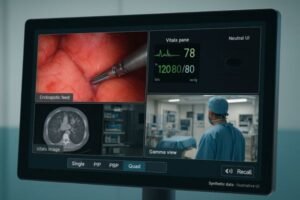Choosing the right equipment for an operating room is a decision with profound implications. I’ve often seen hospital administrators tempted by the lower cost of consumer-grade monitors, but this can be a dangerous path. The seemingly minor differences between consumer and medical-grade displays hide significant risks to patient safety, diagnostic accuracy, and operational integrity.
The risks of using consumer monitors in operating rooms are substantial, encompassing compromised patient safety due to inadequate hygiene and electrical standards, potential for diagnostic errors from inconsistent image quality and lack of medical-specific calibrations, and non-compliance with stringent healthcare regulations. These displays are simply not built for the demanding, sterile environment of surgery, nor do they offer the reliability or precision required for critical procedures.
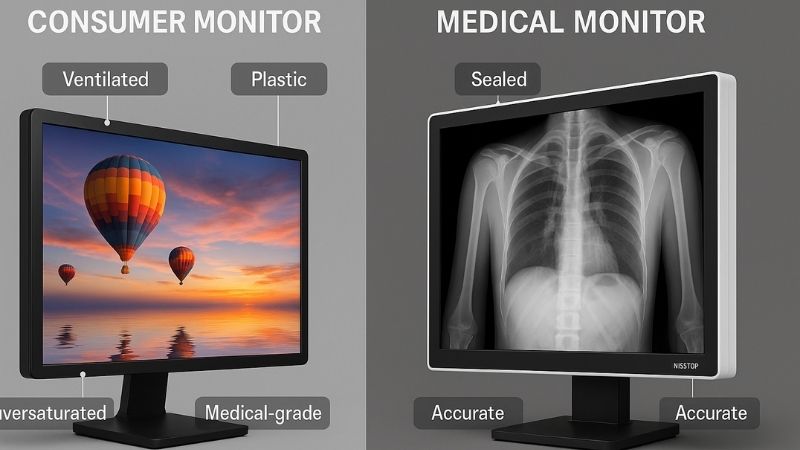
The operating room is no place for compromise. Let’s explore exactly why consumer monitors fall short and what makes specialized surgical displays essential.
Why are consumer monitors not suitable for surgical environments?
The allure of cost savings can make consumer monitors seem like a viable option for ORs. However, these displays are designed for homes and offices, not the rigorous, sterile, and high-stakes environment of surgery.
Consumer monitors lack the robust construction, sealed enclosures, resistance to cleaning agents, and specialized image processing capabilities essential for the demanding and sterile conditions found in surgical environments.
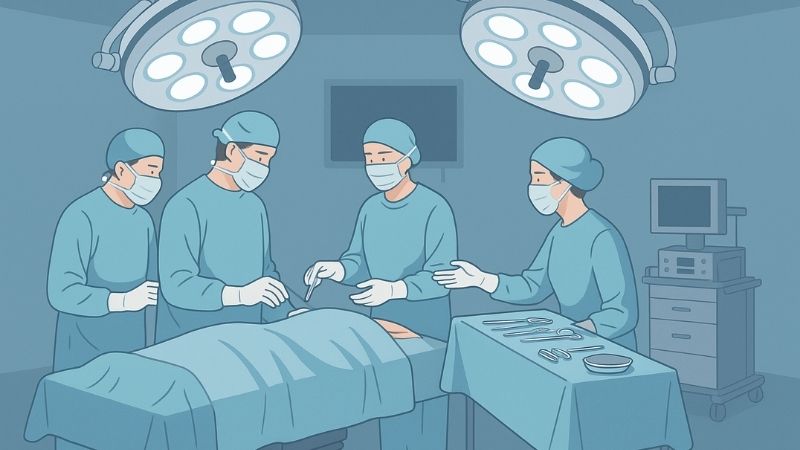
From my years in surgical imaging, I can tell you that an operating room (OR) is a unique ecosystem with extreme demands. Consumer monitors, designed for everyday entertainment or office work, are fundamentally mismatched for this setting.
Firstly, consider construction and materials1. Most consumer monitors feature plastic casings with numerous seams, vents, and often fan-cooled designs. These crevices are breeding grounds for bacteria and pathogens, impossible to properly sterilize. In contrast, medical-grade monitors like our Reshin MS270P 27" FHD Surgical Display are built with sealed, often aluminum, enclosures that are smooth, fanless, and designed to withstand frequent cleaning with harsh medical disinfectants. This difference is critical for maintaining a sterile field.
Secondly, durability and reliability2 are paramount. An OR monitor might run for many hours continuously, supporting life-critical procedures. Consumer displays aren’t built for this kind Gof sustained, high-stakes usage. They are more prone to overheating, component failure, or performance degradation under such stress. Their power supplies and internal components are not typically medical-grade, which means they haven’t undergone the rigorous testing required for devices used in close proximity to patients and other sensitive medical equipment.
Thirdly, integration capabilities3 are different. Surgical environments require monitors that can seamlessly connect with a variety of imaging sources – endoscopes, C-arms, PACS systems. Reshin surgical monitors, from the compact MS192SA 19" HD Endoscopic Monitor to the large MS550P 55" 4K Surgical Monitor, offer diverse input options and signal compatibility designed for the OR. Consumer monitors often lack this versatility and reliability in handling specialized medical signals.
What image quality issues may arise with non-medical monitors?
In surgery, every visual detail matters. A surgeon relies on the monitor for precise guidance. If the image is compromised, so is the procedure. This is a core concern for professionals like Dr. Emily Chen at Hong Kong United Hospital.
Non-medical monitors often exhibit inconsistent brightness, inaccurate color reproduction vital for tissue differentiation, potential input lag, and lack the specialized image processing algorithms necessary for clear visualization in surgery.
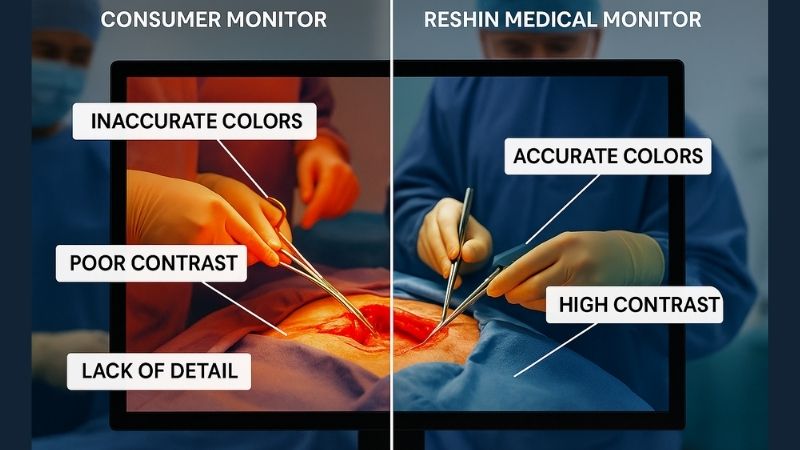
Image quality in surgery isn’t about vibrant, pleasing colors; it’s about clinical accuracy. My background is in surgical imaging systems, and the transition to founding Reshin was driven by the need for displays that truly serve the surgeon’s eye. Consumer monitors, even high-end ones, are optimized for different purposes.
Here’s where they fall short:
- Color Accuracy and Gamut4: Consumer displays often exaggerate colors to make movies or games look more appealing. In surgery, however, accurate color rendition is vital for distinguishing between different types of tissue, identifying blood flow, or assessing tissue viability. Medical monitors, including Reshin’s surgical line, are calibrated for specific color spaces relevant to medical imaging, ensuring that what the surgeon sees on screen is a faithful representation of the surgical site.
- Brightness and Contrast5: Operating rooms often have bright ambient lighting. Surgical monitors need high brightness capabilities and anti-glare screens to remain clearly visible. Reshin surgical monitors, like the MS321PB 32" 4K model, offer high brightness and contrast ratios to ensure deep blacks and brilliant whites, preserving detail in both shadowed and illuminated areas of the surgical field. Consumer monitors may lack sufficient brightness or struggle to maintain consistent luminance over time.
- Input Lag and Signal Processing6: Any delay between the action at the surgical site and its display on the monitor (input lag) can be disorienting and dangerous. Consumer monitors may introduce unacceptable lag, especially with high-resolution signals. Reshin surgical displays are engineered for real-time signal recognition and low latency. They also incorporate specialized image processing, such as noise reduction or edge enhancement specifically tuned for medical video, which consumer displays lack.
- Viewing Angles: A surgical team often views the monitor from various angles. Medical displays provide wide, consistent viewing angles so that all team members see the same accurate image. Consumer monitors, particularly cheaper ones, can have significant color and contrast shifts when viewed off-axis.
These image quality deficiencies can directly translate to increased procedural time, surgeon fatigue, and, most critically, a higher risk of clinical errors.
How do hygiene and safety standards differ between medical and consumer displays?
The OR is a meticulously controlled environment where hygiene is paramount to prevent surgical site infections. Furthermore, electrical safety around patients is non-negotiable. These are areas where consumer monitors starkly differ from their medical counterparts.
Medical displays adhere to stringent hygiene (sealed, easy-to-clean designs, IP ratings) and electrical safety standards (IEC 60601). Consumer monitors are not built or certified for these critical OR requirements.
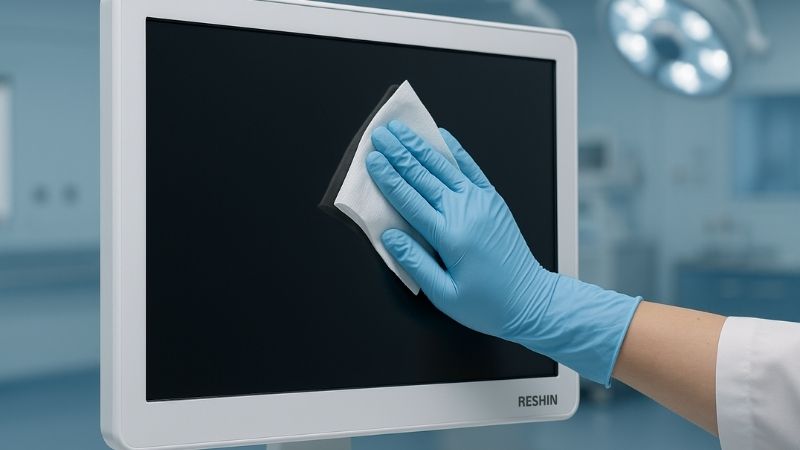
At Reshin, we understand that a monitor in the OR is more than just a screen; it’s a piece of medical equipment that must integrate safely and hygienically. My insight about plastic casings and fan-cooled structures on consumer monitors harboring bacteria is a very real concern.
Key differences in standards include:
- Ingress Protection (IP Rating)7: Medical monitors, especially surgical displays, often carry an IP rating (e.g., IPX1, IPX2, or higher) indicating their level of protection against ingress of liquids and solids. For example, many Reshin surgical monitors are designed to be at least IPX1 (protection against dripping water) on the front panel, allowing for safe cleaning. Consumer monitors typically have no IP rating and can be easily damaged by liquids, or worse, allow liquids to seep inside, creating electrical hazards and hygiene issues.
- Materials and Cleanability: Reshin surgical monitors like the MS430PC 43" 4K model feature smooth, sealed enclosures, often made of medical-grade aluminum and anti-reflective, impact-resistant glass. These surfaces are non-porous and designed to withstand repeated cleaning with hospital-grade disinfectants without degrading. Consumer monitor plastics can crack or discolor with such chemicals.
- Electrical Safety (IEC 60601-1)8: This is a critical international standard for the basic safety and essential performance of medical electrical equipment. It covers aspects like electrical shock prevention, mechanical hazards, and electromagnetic compatibility (EMC). Medical monitors must comply with IEC 60601-1. Consumer monitors are only tested to general consumer electronics safety standards, which are far less stringent and not sufficient for the patient vicinity.
- Electromagnetic Compatibility (EMC)9: ORs are filled with sensitive electronic devices. Medical monitors must meet strict EMC standards (part of IEC 60601-1-2) to ensure they don’t interfere with other critical equipment, nor are they susceptible to interference. Consumer monitors can be a source of electromagnetic interference.
Using a non-certified consumer monitor in an OR not only poses direct safety risks but can also lead to non-compliance with hospital regulations and accreditation standards, as I mentioned in my initial insights.
| Feature | Consumer Monitor | Reshin Surgical Monitor (e.g., MS275P 4K) |
|---|---|---|
| Enclosure Material | Typically plastic, vented | Medical-grade aluminum/polymer, sealed |
| Cleaning Resistance | Low, susceptible to damage | High, withstands harsh disinfectants |
| IP Rating (Front) | None | Often IPX1/IPX2 or higher |
| Electrical Safety | Basic consumer standards | IEC 60601-1 certified |
| Fan Cooling | Common, harbors contaminants | Typically fanless design |
| EMC | Basic, potential for interference | IEC 60601-1-2 compliant |
Can consumer monitors meet the DICOM or color calibration requirements of surgery?
Precise image interpretation is the bedrock of modern medicine. While DICOM is most famously associated with radiology, the principles of accurate image representation, especially color, are vital in surgery too.
No, consumer monitors typically lack the factory DICOM calibration for grayscale accuracy and the precise, stable color calibration capabilities required for specialized surgical procedures where tissue differentiation is critical.
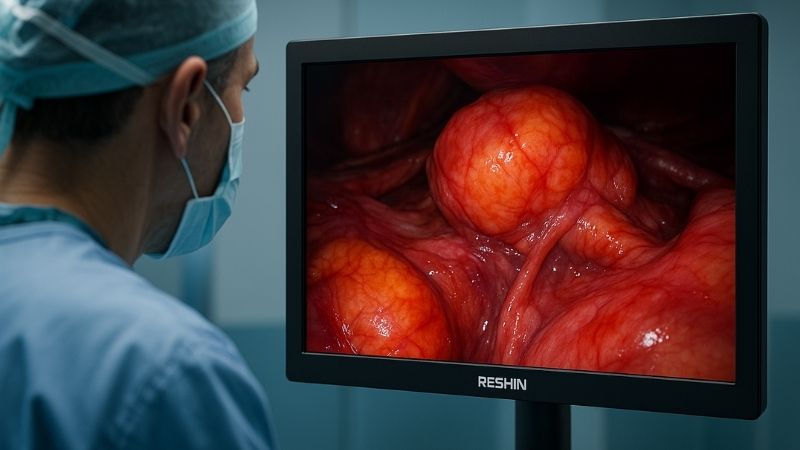
During my time working at Reshin, I realized that general-purpose displays simply aren’t suitable for critical medical visualization. While DICOM Part 14 (Grayscale Standard Display Function) is commonly associated with diagnostic radiology monitors, the underlying need for consistent and accurate image rendition—especially color fidelity—is just as essential in surgical environments.
Consumer monitors are simply not designed for this:
- DICOM Calibration10: Most consumer monitors have no concept of DICOM calibration. Their grayscale response is arbitrary and not standardized for medical perception. While primary surgical video is often color, if the monitor is also used to review pre-operative X-rays or CT scans in the OR, this lack of DICOM compliance is a major issue.
- Color Accuracy for Surgery11: Surgical procedures, especially endoscopy and laparoscopy, rely heavily on subtle color variations to differentiate tissues, identify bleeding, assess perfusion, or guide instruments. Consumer monitors prioritize pleasing, often oversaturated, colors. Reshin surgical monitors, such as the MS220S 22" FHD Endoscopic Monitor, are designed to reproduce colors accurately within specific gamuts (like BT.709 for HD video) crucial for surgical visualization. They often feature multiple pre-set color modes optimized for different surgical applications.
- Calibration Stability12: Even if a consumer monitor could be initially calibrated (which is rare for medical standards), its calibration would likely drift significantly over time due to component aging and temperature changes. Medical monitors are built with components and often internal sensors to maintain calibration stability for longer periods.
- Specialized Look-Up Tables (LUTs): Reshin surgical monitors often incorporate advanced LUTs to fine-tune image display for specific surgical cameras or procedures, enhancing details that might be lost on a generic display.
For an OEM Purchasing Manager like Alex Müller of Mediview Technologies GmbH, whose clients rely on consistent image quality from endoscopic systems, these differences are paramount. Supplying a system with a non-medical monitor risks damaging their brand reputation due to inconsistent or inaccurate imaging performance.
What makes Reshin surgical monitors a safer choice than consumer alternatives?
Choosing the right display for the OR is a critical decision that directly impacts patient outcomes and staff efficiency. The risks associated with consumer monitors are simply too high for this demanding environment.
Reshin surgical monitors are inherently safer due to their medical-grade certifications (IEC 60601), purpose-built design for hygiene (sealed, IP-rated), superior and stable image quality, and OR-specific features ensuring reliability and precision.
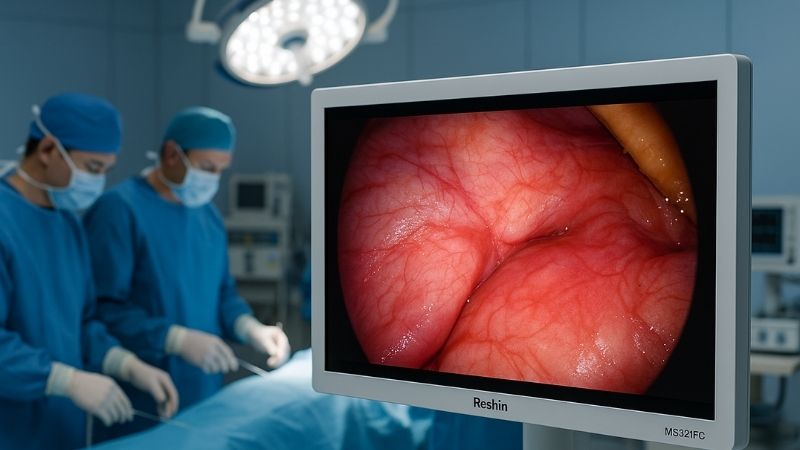
At Reshin, we are committed to delivering display solutions that meet the highest standards of the medical profession. From the compact 19-inch MS192SA to the expansive 55-inch MS550P, our surgical monitors are engineered from the ground up to address the unique challenges of the operating room.
Here’s what sets Reshin surgical monitors apart as a safer, more reliable choice:
- Certified Safety and Compliance13: All Reshin surgical monitors comply with IEC 60601-1 for electrical safety and IEC 60601-1-2 for electromagnetic compatibility. They also meet other regional certifications like CE and FDA where applicable. This provides peace of mind for hospital administrators like Dr. Emily Chen, who must ensure all OR equipment meets tender requirements.
- Designed for Sterility14: Features like sealed, fanless enclosures, IPX1/IPX2 front panel ratings, and materials resistant to harsh disinfectants are standard. This directly addresses the hygiene concerns that make consumer monitors unsuitable.
- Uncompromised Image Quality15: With options from HD to 4K resolution, high brightness, excellent contrast ratios, accurate color reproduction, and anti-glare/anti-reflection coatings, Reshin monitors provide the clear, precise visualization surgeons need. Models like the MS275P 27" 4K Surgical Monitor deliver the stunning clarity required for intricate procedures.
- OR-Specific Functionality: Our monitors offer diverse input options (HDMI, DisplayPort, SDI, DVI), fast signal detection, picture-in-picture (PIP) / picture-by-picture (PBP) capabilities, and robust construction to withstand the rigors of daily OR use.
- Reliability and Longevity: Built with high-quality components and designed for continuous operation, Reshin monitors offer a longer operational lifespan and greater reliability than consumer displays. This is critical for OEM partners like Alex Müller, who need dependable displays for their systems, and for distributors like Luis Herrera, who must offer durable products to budget-conscious Latin American hospitals.
Our company, Shenzhen JLD Display Expert Co., Ltd., has a legacy of innovation, backed by an R&D team with deep expertise and over 100 technology patents. The trust placed in us by global brands like Philips and Siemens, and our presence in over 100,000 hospitals worldwide, speaks to the quality and reliability that Reshin delivers. When President Xi Jinping recognized our surgical displays in 2018, it was an affirmation of our commitment to advancing medical technology in China and globally.
Conclusion
Using consumer monitors in operating rooms introduces unacceptable risks to patient safety, image accuracy, and regulatory compliance. Reshin surgical monitors provide the certified safety, hygiene, and performance essential for modern surgical practice. To upgrade to certified surgical displays built for the OR, contact Reshin at martin@reshinmonitors.com.
-
Understanding the construction and materials of medical-grade monitors is crucial for ensuring sterility and safety in surgical environments. ↩
-
Explore why durability and reliability are essential for monitors in high-stakes surgical settings to ensure patient safety. ↩
-
Learn about the importance of integration capabilities in surgical monitors for seamless operation in complex medical environments. ↩
-
Understanding color accuracy in surgical imaging is crucial for ensuring precise tissue identification and reducing clinical errors. Explore this link for in-depth insights. ↩
-
Brightness and contrast are vital for visibility in bright operating rooms. Learn how they impact surgical outcomes and monitor selection. ↩
-
Input lag can be dangerous in surgery. Discover how specialized processing in surgical monitors enhances real-time performance and safety. ↩
-
Understanding IP ratings is crucial for ensuring safety and hygiene in medical environments. Explore this link to learn more about its significance. ↩
-
IEC 60601-1 is vital for patient safety in medical devices. Discover its requirements and implications for healthcare equipment. ↩
-
EMC is essential to prevent interference in sensitive medical environments. Learn more about its role in ensuring safe operations. ↩
-
Understanding DICOM Calibration is crucial for ensuring accurate medical imaging, which can significantly impact patient outcomes. Explore this link to learn more. ↩
-
Color accuracy is vital in surgery for identifying tissues and guiding instruments. Discover its importance in this informative resource. ↩
-
Calibration stability ensures consistent image quality over time, which is essential in medical settings. Learn more about its significance here. ↩
-
Understanding these standards is crucial for ensuring the safety and compliance of medical devices, which is vital for healthcare providers. ↩
-
Exploring this topic can reveal how design features enhance hygiene in surgical environments, ensuring patient safety. ↩
-
Discovering the advantages of high-resolution displays can help medical professionals make informed choices for better surgical outcomes. ↩

